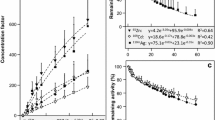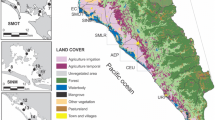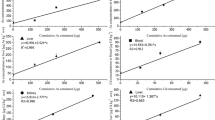Abstract
Exposure to Cd and/or109Cd has shown that the element was efficiently accumulated in oysters and soybeans as well as in rats. Differential centrifugation of oyster, soybean, rat liver, and rat kidney homogenates followed by analysis showed that Cd was associated primarily with proteins in the 105,000×g supernatants. Separation of these proteins by Sephadex chromatography and subsequent analysis by atomic absorption spectroscopy or by radioactivity measurements revealed that Cd in oysters and rat organs was principally bound to proteins of 9,200 to 13,800 molecular weight. A significant amount of Cd in oysters was also associated with fractions of > 50,000 and < 3,000 molecular weights. Almost all of the Cd in soybeans was found to be bound to molecules of > 50,000 molecular weight.
Similar content being viewed by others
References
Andrews, P.: The gel-filtration behavior of proteins related to their molecular weight over a wide range. Biochem. J.96, 595 (1965).
Beckman Instrument Co., Fullerton, Calif., Microzone Electrophoresis Manual, RM-IM-3.
Flick, D. F., H. F. Kraybill, and J. J. Dimitroff: Toxic effects of cadmium. A review. Environ. Res.4, 71 (1971).
Kagi, J. H. R., and B. L. Vallee: Metallothionein: A cadmium- and zinc-containing protein from equine renal cortex. J. Biol. Chem.235, 3460 (1960).
Kagi, J. H. R., and B. L. Vallee: A cadmium- and zinc-containing protein from equine renal cortex. II. Physiocochemical properties. J. Biol. Chem.236, 2435 (1961).
Kuwata, K., K. Hisatomi, and T. Hasegawa: The rapid determination of trace amounts of cadmium and copper in river and sea water by atomic absorption spectroscopy. Atomic Absorption Newsletter10, 111 (1971).
Lowry, O. H., N. J. Rosebrough, A. L. Farr, and R. J. Randall: Protein measurement with the Folin phenol reagent. J. Biol. Chem.193, 265 (1951).
Moore, S., and W. H. Stein: Photometric ninhydrin method for use in the chromatography of amino acids. J. Biol. Chem.176, 367 (1948).
Piscator, M.: On cadmium in normal human kidneys together with a report on isolation of metallothionein from livers of cadmium-exposed rabbits. Nord. Hyg. Tidsk.45, 76 (1964).
Pulido, P., H. R., Kagi, and B. L. Vallee: Isolation and some properties of human metallothionein. Biochemistry5, 1768 (1966).
Shaikh, Z. A., and O. J. Lucis: Isolation of cadmium-binding proteins. Experientia27, 1024 (1971).
Author information
Authors and Affiliations
Rights and permissions
About this article
Cite this article
Casterline, J.L., Yip, G. The distribution and binding of cadmium in oyster, soybean, and rat liver and kidney. Arch. Environ. Contam. Toxicol. 3, 319–329 (1975). https://doi.org/10.1007/BF02220744
Received:
Accepted:
Issue Date:
DOI: https://doi.org/10.1007/BF02220744




